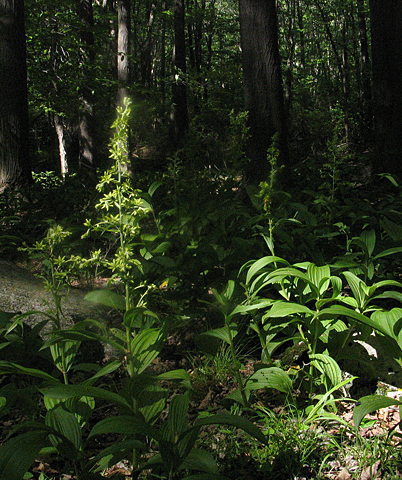Action, Medical Uses, and Dosage.—Veratrine does not represent the action of this plant, which contains but a small proportion of this body. Applied to the skin, veratrum is rubefacient, and to the nose, excites sneezing. Small doses of veratrum appear, at first, not to affect the frequency of the pulse, but to lower its force; it afterward slows the pulse, it becoming moderately full and soft, and remaining so, unless the patient, during this stage of depression, attempts to rise or makes any exertion when the pulse becomes very rapid, small, thready, and sometimes almost imperceptible. During the stage of depression, there is marked muscular weakness and relaxation, and nausea and vomiting take place, the contents of the stomach being evacuated first, and then those of the gall-bladder. The nausea produced by veratrum is intense, and the vomiting severe and often persistent, making it, therefore, an unsafe emetic. The most characteristic action of veratrum is its effects upon the movements of the heart and upon vascular tonus. The pulse-rate has been lowered to 35 beats a minute with this agent, a corresponding depression of force accompanying this action. Toxic doses produce an exceedingly weak heart-action, almost indistinguishable, running pulse, reduced temperature, cold, clammy sweat, extreme retching, and incessant vomiting, dizziness, faintness, failure of sight, pupillary dilatation, complete muscular prostration, slow, shallow breathing, sleepiness, coma, and unconsciousness, with sometimes stertorous breathing. The prompt emesis induced by this agent, undoubtedly prevents lethal effects.
The lower leaves are large, from 6 to 12 inches long, half as wide, oval, acuminate, pubescent, strongly plaited and nerved, the lower part of their edges meeting round the stem; the upper leaves are gradually narrower; the uppermost, or bracts, are linear and lanceolate; all alternate. The flowers are numerous, green, in compound racemes axillary from the upper leaves, and terminal; the whole forming a sort of panicle.
History and Description.—American hellebore is indigenous to the United States and Canada, growing in swamps, low grounds, and moist meadows, usually associated with Skunk-cabbage, and flowering in June and July. The medicinal virtues of the drug seem to reside in the rhizome alone. In the mountains of Oregon, however, where the plant grows in abundance, it is considered one of the very best of sheep foods, and passes under the name of Wild Indian corn. The sheep fatten on it in the spring and early summer. Either the western plant is a distinct species or variety, which I doubt, or the leaves and stems are not poisonous."




